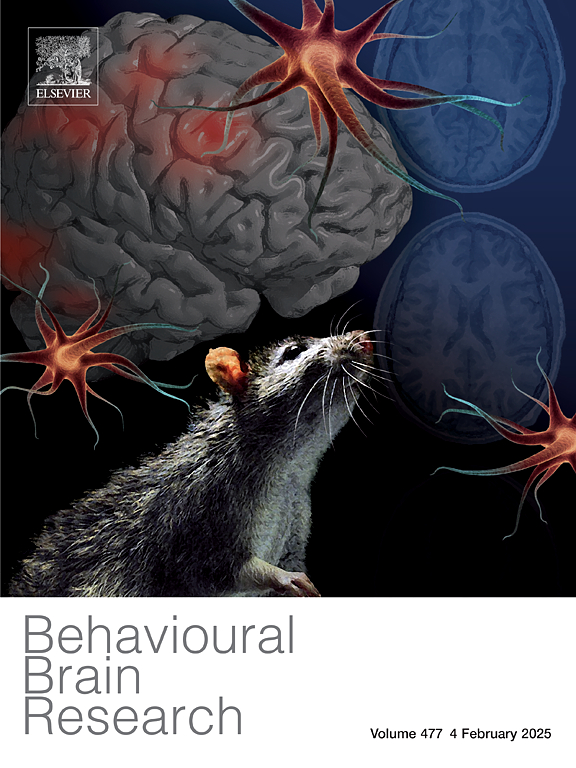Colchicine alleviates ischemic white matter lesions and cognitive deficits by inhibiting microglia inflammation via the TAK1/MAPK/NF-κB signaling pathway
IF 2.6
3区 心理学
Q2 BEHAVIORAL SCIENCES
引用次数: 0
Abstract
White matter lesions (WMLs) caused by chronic cerebral hypoperfusion (CCH) are closely related to the activation of microglia. Inhibition of microglia overactivation is considered as a protective strategy for WMLs. Based on its anti-inflammatory properties and clinical benefits, colchicine has become a hot spot in the drug treatment and research of vascular diseases. However, its role in vascular cognitive impairment (VCI) remains unclear. In this study, BCAS model was established to induce CCH, simulate subcortical white matter lesions, and examine the effect of colchicine on WMLs after BCAS. The basic parameters of body weight and blood pressure were monitored. Behavioral evaluation included the Open Field test, Y maze and Morris Water Maze to evaluate the motor ability and cognitive level of mice respectively. The cerebral blood flow was detected by Laser Speckle Imaging (LSI). Transmission Electron Microscopy, LFB staining, corpus callosum MBP and MAG western blot levels, and mouse brain T2-weighted imaging were used to detect demyelination and white matter changes. The expression of IBA1 was determined by immunohistochemistry and western blot, and the correlation between IBA1 staining and behavioral parameters was analyzed. The expression of brain inflammatory factors was detected by Elisa. It was found that colchicine may alleviates VCI through MAPK/NF-κB pathway by means of network pharmacology enrichment analysis from the perspective of inflammation, and the classical inflammatory proteins TAK1, p38, JNK, and p65 of this pathway were subsequently detected in in vivo and in vitro models. The anti-inflammatory spectrum of colchicine, including IL-1β, IL-6, COX2, CD86 and anti-inflammatory effects, were extensively evaluated by RT-qPCR, western blot, wound healing and transwell tests on BV2 microglia stimulated by low concentration of LPS in vitro. This study shows that colchicine can improve the cognitive impairment of BCAS mice, and the specific mechanism is to regulate the inflammation of microglia by inhibiting the classical inflammatory pathway of TAK1/MAPK/NF-κB, thereby reducing WMLs and improving the cognitive impairment behavior.
秋水仙碱通过TAK1/MAPK/NF-κB信号通路抑制小胶质细胞炎症,减轻缺血性白质病变和认知缺陷
慢性脑灌注不足(CCH)引起的白质病变(WMLs)与小胶质细胞的激活密切相关。抑制小胶质细胞过度激活被认为是脑损伤的一种保护策略。秋水仙碱因其抗炎特性和临床疗效,已成为血管疾病药物治疗和研究的热点。然而,其在血管性认知障碍(VCI)中的作用尚不清楚。本研究通过建立BCAS模型,诱导CCH,模拟皮层下白质病变,观察秋水仙碱对BCAS后脑白质损伤的影响。监测体重、血压等基本参数。行为学评价采用Open Field实验、Y迷宫和Morris水迷宫分别评价小鼠的运动能力和认知水平。采用激光散斑成像(LSI)检测脑血流。采用透射电镜、LFB染色、胼胝体MBP和MAG western blot及小鼠脑t2加权成像检测脱髓鞘和白质变化。免疫组织化学和western blot检测IBA1的表达,分析IBA1染色与行为参数的相关性。Elisa法检测脑炎性因子的表达。从炎症角度通过网络药理学富集分析发现秋水仙碱可能通过MAPK/NF-κB通路缓解VCI,并随后在体内和体外模型中检测该通路的经典炎症蛋白TAK1、p38、JNK、p65。采用RT-qPCR、western blot、创面愈合及transwell实验对体外低浓度LPS刺激的BV2小胶质细胞进行抗炎作用,评价秋水仙碱的抗炎谱,包括IL-1β、IL-6、COX2、CD86及抗炎作用。本研究表明,秋水仙碱可改善BCAS小鼠认知功能障碍,其具体机制是通过抑制TAK1/MAPK/NF-κB经典炎症通路调节小胶质细胞炎症,从而减少脑损伤,改善认知功能障碍行为。
本文章由计算机程序翻译,如有差异,请以英文原文为准。
求助全文
约1分钟内获得全文
求助全文
来源期刊

Behavioural Brain Research
医学-行为科学
CiteScore
5.60
自引率
0.00%
发文量
383
审稿时长
61 days
期刊介绍:
Behavioural Brain Research is an international, interdisciplinary journal dedicated to the publication of articles in the field of behavioural neuroscience, broadly defined. Contributions from the entire range of disciplines that comprise the neurosciences, behavioural sciences or cognitive sciences are appropriate, as long as the goal is to delineate the neural mechanisms underlying behaviour. Thus, studies may range from neurophysiological, neuroanatomical, neurochemical or neuropharmacological analysis of brain-behaviour relations, including the use of molecular genetic or behavioural genetic approaches, to studies that involve the use of brain imaging techniques, to neuroethological studies. Reports of original research, of major methodological advances, or of novel conceptual approaches are all encouraged. The journal will also consider critical reviews on selected topics.
 求助内容:
求助内容: 应助结果提醒方式:
应助结果提醒方式:


